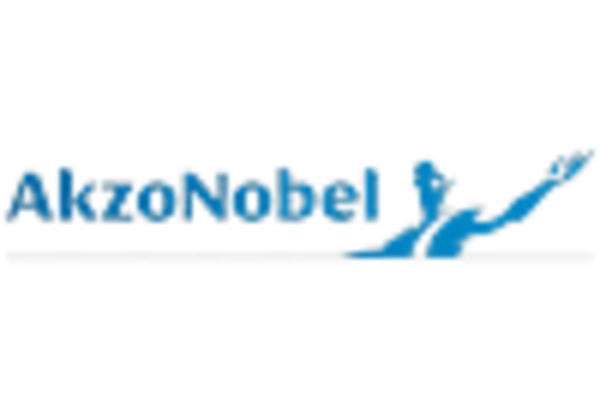Growing Environmental Awareness
The increasing awareness regarding environmental issues is a primary driver for the Green Chemistry Chemicals Market. Consumers and industries alike are becoming more conscious of their ecological footprint, leading to a shift towards sustainable practices. This heightened awareness has prompted companies to adopt green chemistry principles, which focus on reducing hazardous substances and minimizing waste. As a result, the market for green chemicals is projected to grow significantly, with estimates suggesting a compound annual growth rate of over 10% in the coming years. This trend indicates a robust demand for environmentally friendly alternatives, thereby driving innovation and investment in the Green Chemistry Chemicals Market.
Regulatory Frameworks and Incentives
The establishment of stringent regulatory frameworks and incentives for sustainable practices is a crucial driver for the Green Chemistry Chemicals Market. Governments are increasingly implementing policies that promote the use of green chemicals, aiming to reduce pollution and enhance public health. For instance, regulations that limit the use of toxic substances in manufacturing processes encourage companies to seek safer alternatives. This regulatory push not only fosters compliance but also stimulates market growth, as businesses invest in green technologies to meet these standards. The Green Chemistry Chemicals Market is likely to benefit from these initiatives, as they create a favorable environment for the adoption of sustainable chemical solutions.
Investment in Research and Development
Investment in research and development (R&D) is a vital driver for the Green Chemistry Chemicals Market. As the need for sustainable solutions intensifies, companies are allocating significant resources to R&D initiatives aimed at developing innovative green chemicals. This investment not only fosters technological advancements but also enhances the competitiveness of firms within the market. With a focus on creating safer, more efficient chemical processes, R&D efforts are likely to yield breakthroughs that can transform the industry landscape. Analysts predict that the ongoing commitment to R&D will play a crucial role in shaping the future of the Green Chemistry Chemicals Market, driving growth and innovation.
Consumer Preference for Sustainable Products
The shift in consumer preferences towards sustainable products is a notable driver for the Green Chemistry Chemicals Market. As consumers become more informed about the environmental impact of their choices, there is a growing demand for products that are not only effective but also eco-friendly. This trend is evident in various sectors, including personal care, cleaning products, and packaging materials, where consumers actively seek out green alternatives. Companies are responding to this demand by reformulating their products to incorporate green chemistry principles, thereby expanding their market share. The Green Chemistry Chemicals Market is poised to grow as businesses align their offerings with consumer expectations for sustainability.
Technological Innovations in Chemical Production
Technological advancements in chemical production processes are significantly influencing the Green Chemistry Chemicals Market. Innovations such as biocatalysis, green solvents, and renewable feedstocks are transforming traditional manufacturing methods, making them more sustainable. These technologies not only enhance efficiency but also reduce the environmental impact of chemical production. For example, the use of biocatalysts can lower energy consumption and minimize waste generation. As these technologies become more accessible, they are expected to drive the growth of the Green Chemistry Chemicals Market, with market analysts projecting a substantial increase in the adoption of these innovative solutions.


















Leave a Comment